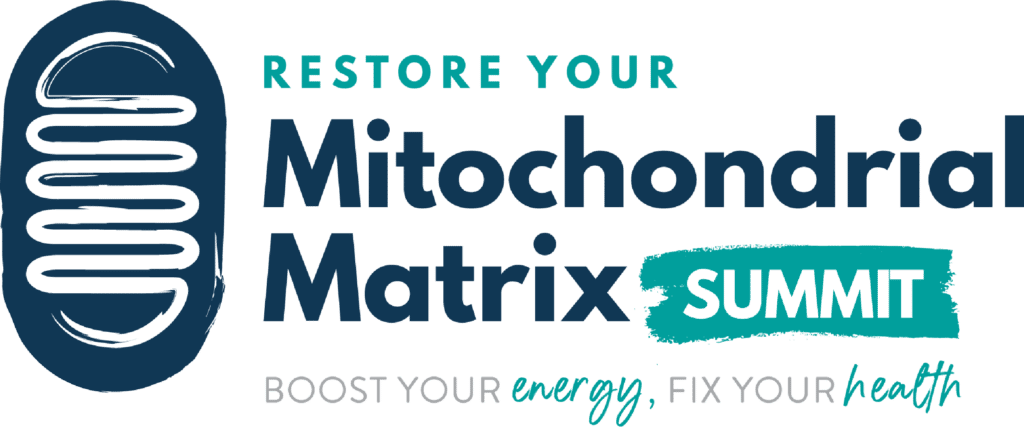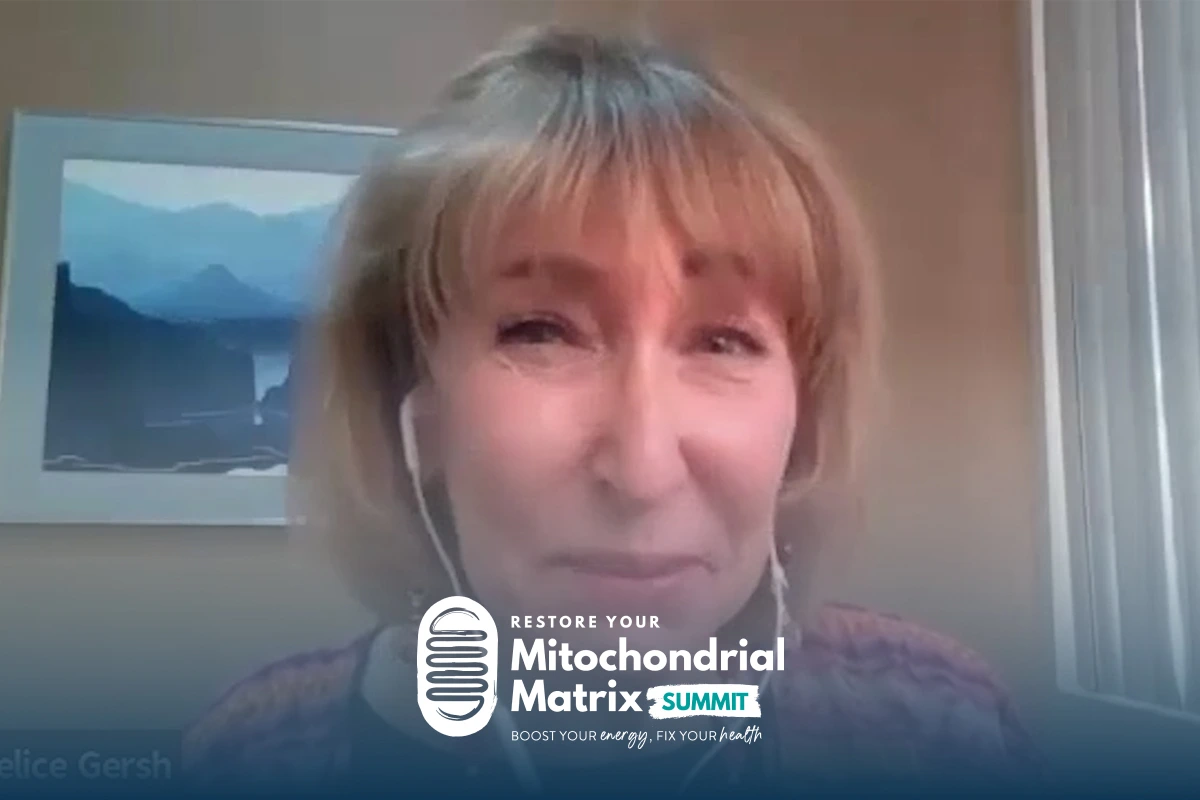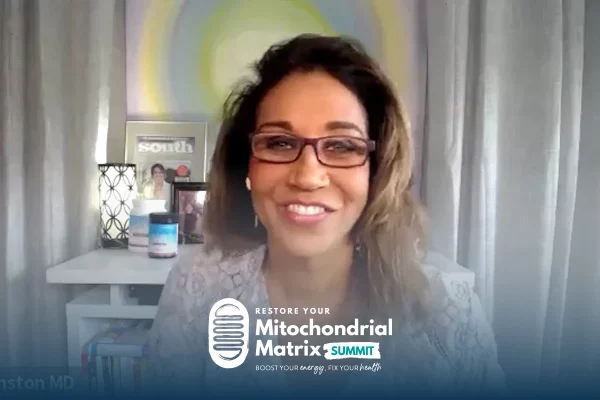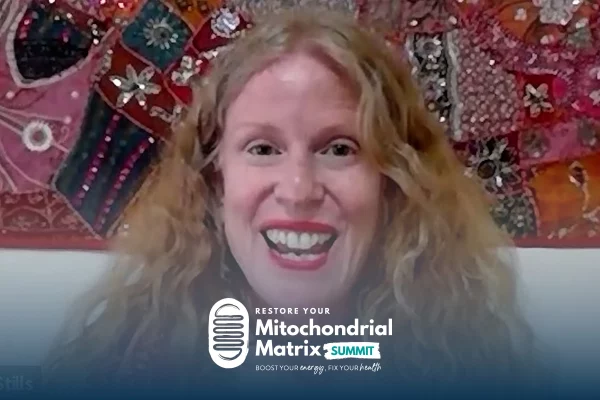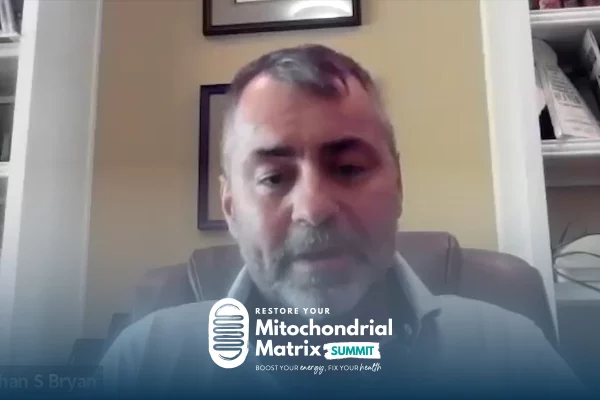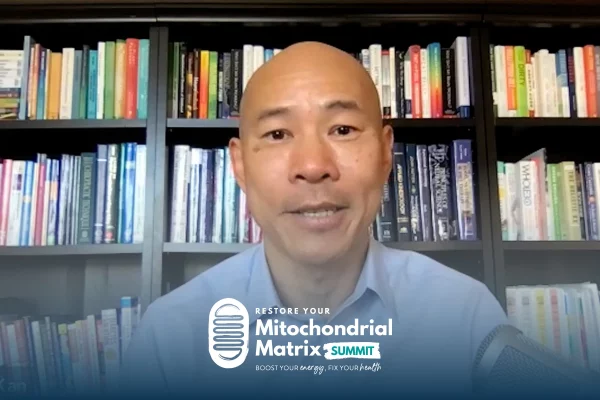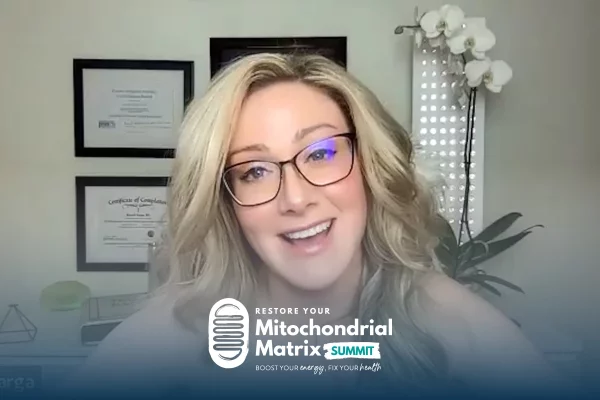Join the discussion below
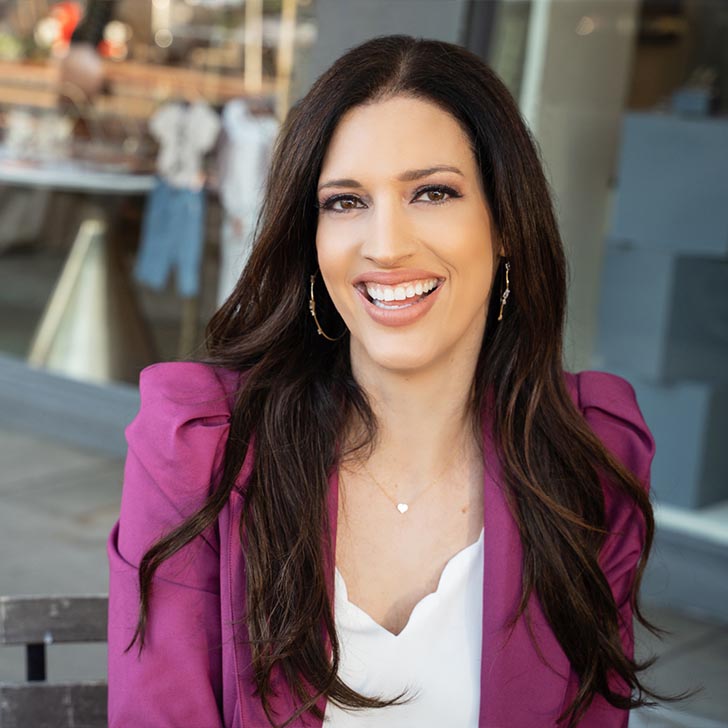
Laura Frontiero, FNP-BC, has served thousands of patients as a Nurse Practitioner over the last 22 years. Her work in the health industry marries both traditional and functional medicine. Laura’s wellness programs help her high-performing clients boost energy, renew mental focus, feel great in their bodies, and be productive again.... Read More

Felice Gersh, MD is a multi-award winning physician with dual board certifications in OB-GYN and Integrative Medicine. She is the founder and director of the Integrative Medical Group of Irvine, a practice that provides comprehensive health care for women by combining the best evidence-based therapies from conventional, naturopathic, and holistic... Read More
- Why you should consider bioidentical hormones, even before menopause sets in
- Why Mitochondrial function is essential to optimal health
- The role estrogen, in the form of estradiol, plays for optimal mitochondrial function
- How estrogen optimizes oxidative phosphorylation and the breakdown of superoxide dismutase
Laura Frontiero, FNP-BC
Welcome back, you’re watching the “Restore Your Mitochondrial Matrix Summit.” I’m your host, Laura Frontiero. I’m bringing you experts to help you boost your energy and fix your health so you can build the life you love. And today my special guest is Dr. Felice Gersh. Hi, Dr. Gersh. Welcome to the summit.
Felice Gersh, M.D.
Oh, welcome to everyone out there who’s here, because this is such an important topic. So I am so thrilled to join you for this summit.
Laura Frontiero, FNP-BC
I am so excited you’re here, too. And funny thing, you’re just right up the road for me. We only live about 40 minutes apart. But such as it goes with these summits, we do them online. So let me introduce you to our audience, because you’ve had quite a career so far. You are a dual Board Certified OBGYN and in integrative medicine, so both. And you still are working in clinical practice. In fact, you’re sitting in your-
Felice Gersh, M.D.
I know. Right.
Laura Frontiero, FNP-BC
Yeah, you had a full clinic day today.
Felice Gersh, M.D.
I did. I’m still very old fashioned. I have a brick-and-mortar practice where I do hands-on and actually see patients in my office. But also I do telemedicine, you know, just like everybody else now. Sometimes people don’t have the means or the time or whatever, and we can do it through the magic of the internet.
Laura Frontiero, FNP-BC
Yes. And so amazing that we have that. Now, your practice, you are the director of the Integrative Medical Group of Irvine, and it is pretty much comprehensive healthcare for women combining evidence-based therapies from conventional, naturopathic, and holistic medicine. So combining it all perfectly. And you are also an affiliate faculty member at the Fellowship in Integrative Medicine through the University of Arizona School of Medicine. And you’ve written a couple books. You’re a bestselling author of the PCOS SOS series, and your latest book, “Menopause: 50 Things You Need to Know.” So we’re gonna, of course, connect mitochondria and estrogen’s essential role.
Felice Gersh, M.D.
Right.
Laura Frontiero, FNP-BC
Right. Because that is your zone of genius right there. So can you start us off? Well, you know, I’d really love to know, why functional medicine? How did you go from being a Western trained physician, OBGYN, and integrating, what happened there?
Felice Gersh, M.D.
Well, from really almost the very beginning of my practice, I knew that there was more than just pharmaceuticals and surgeries to keep women optimally healthy. But I didn’t have any additional special training. But I brought into my practice really early on a nutritionist and a Chinese medicine practitioner who did acupuncture, Chinese herbs. I had a psychologist, massage therapist, biofeedback. So I knew I needed to have all of these wonderful teammates, but I didn’t actually learn anything different myself. I would just incorporate them into my treatment plan. But then I finally, after 25 years, thousands of deliveries, it was my time to move on from doing obstetrics.
So after that, maybe I had a little more sleep, a little bit more time, I insisted on having all of the pharmaceutical reps that paraded through my office on a very regular basis to actually sit down with me and show me the studies that allowed their pharmaceutical to become FDA approved. And it was quite shocking. Some of the medications that I prescribed regularly had very low efficacy when you compared them to placebo, but quite a large array of side effects. And I felt, oh my gosh, what the heck am I doing now that I’m not doing deliveries? These pharmaceuticals are offering very little in terms of benefits, and they’re really, they’re not curing anything. Maybe they’re a little bit alleveing symptoms, and even not that much. And there’s no exit strategy for these drugs. What, are you supposed to be on them for the rest of your life? And I love surgery.
I taught surgery for many years at USC to the residents, but that’s all end-stage disease. I didn’t really want to just feel like I have to clean up the pieces after everything’s fallen apart. So I wanted to be more proactive, and I didn’t have the tools. I really didn’t know what to do. As you know, we talked about this before we came on, they don’t teach you these things. You don’t know how to prevent disease, and you’re not that great at fixing it either. You know, cutting out organs is not really our goal in life for caring for women. So I went on my own little journey like everybody else who ends up in this field, and I started taking courses with just people I’d never even heard of like naturopaths, and I didn’t know what chiropractors did and nutritionists. So I just was roaming around taking all these courses, and I ended up at a naturopathic conference, and there just happened to be one other MD who was doing lectures. And I went up to her at the break, and I said, “Dr. Low Dog, you and I are the only MDs in this room, and I have no idea, I have like no real path. I’m just sort of randomly taking courses.
I’m learning a lot, but it doesn’t feel very organized.” And she said, “You know, talking to you, I know you’re qualified. We have a new course starting in two weeks at the Integrative Fellowship in Integrative Medicine at the University of Arizona School of Medicine. So I went home from the conference on Sunday night, I filled out the application, and two weeks later, I was in Tucson. I did the two-year fellowship and I never looked back. I became one of the very early group that actually became officially board certified in the new field of integrative medicine with very few who were actually also OBGYNs. And that was the start of my own personal journey as an integrative and functional medicine doctor. So from that point on, I educated myself. I’ve now been the proud author of multiple articles that have been published in major prestigious peer-reviewed journals.
Like I had a new article that just came out this past December, and it was the featured article chosen by the editor of “Mayo Clinic Proceedings.” I’ve had articles in the British medical journal “Heart.” And so I’ve really tried to spread the word beyond our little community of functional and integrative practitioners into the broader conventional world. So I wanna be that bridge to educate across all lines, you know, no barriers for me, no borders. So I wanna educate the public. I wanna educate doctors who know nothing about this whole field and understand how women’s bodies really work so that women, no matter who they actually end up with as their healthcare provider, will actually get care that is designed to help them to really achieve optimal health, which is not the conventional approach, as we know. So it’s an ongoing journey, and I’m so excited to be part of this movement. It’s really what medicine should be.
Laura Frontiero, FNP-BC
It is, and wow, what a distinguished career you’ve had and still going. It’s like you’re just getting started. With your mission to really help women understand their bodies and to really bridge the whole Western and functional and integrative medicine communities, could you start off by sharing with us just a quick review, perfect for you since you are a professor as well, could you review mitochondrial function and its role in metabolic and reproductive health? Because I think it’s really important for women to understand, why are we talking about mitochondria when we’re talking about menopause and estrogen and all that?
Felice Gersh, M.D.
So one of the things that distinguishes something that is alive versus something that isn’t alive is the amazing ability of living creatures to actually produce energy. I mean, it’s amazing. Energy is what metabolism is all about. So people talk about, I have a fast metabolism, I have a slow metabolism. Metabolism is really the creation, production, storage, distribution of energy. And as we age, all living creatures, without any additional help and of course the natural course of things is going to be that their capability of making energy declines. So if you go to a park on a nice day, you see all the children running around and having fun, the young people tossing Frisbees, and all the old people sitting on benches. It’s not because old people love benches. It’s ’cause they don’t have the energy. And that’s what mitochondria do.
They are the energy producers, the powerhouses of the cells. And different organs have different concentrations, like the heart, and we can talk about why women’s hearts are really different. Women have far more mitochondria in their hearts than do men, and this is really critical for getting through a pregnancy health, you know, getting a good outcome. And the brain is filled with mitochondria. Of course, every single cell that creates energy has to have mitochondria. And what is not well understood is estrogen. So estrogen has to be present for mitochondria to work optimally. And it’s so important that women really embrace and understand estrogen, not just as a hormone that’s involved in pregnancies, fertility, and menstrual periods, but as the hormone that really regulates metabolism.
And it’s really essential, of course, for a woman to be healthy in every organ system in order for her to be successful as a reproductive creature. And that’s what it is, the prime directive of life. I figured this out early in my career while I was delivering all those babies. Whether we want to accept this, it is what it is, the prime directive of life is the creation of new life, and remembering that only humans, they’re the only species on this planet that tries to control their reproductive destiny, right? There’s no other animal that says, hmm, you know, I’m actually going into heat, and this is my reproductive time, but I think I’ll pass this year. It doesn’t work that way, you know?
So we need to know that female bodies are really designed for optimal fertility, and that estrogen is like the glue that maintains metabolism, optimal metabolic health, which means optimal mitochondrial function and reproductive function. Because you need a healthy body to be able to make a healthy baby. And I try to spread this word. So understanding the linkage between all metabolic functions in the body and all of reproductive functions is critical to understanding how women’s bodies work, and that along with that, when women lose their estrogen production from their ovaries, they’re going to have a huge metabolic hit. Every organ in the body is going to be functioning at a less optimal level because of this deficiency, insufficiency of estrogen in the form of estradiol. And it’s not just the end of reproductive life. It’s really this major metabolic shift in the body, and changes are occurring at every level, including those critical little organelles, the mitochondria, that create the spark of life, energy itself.
Laura Frontiero, FNP-BC
Wow. Okay. So you’ve just established how important estrogen is in mitochondria. And this loss of estrogen as we get older, I can remember back before 2008 or so when we were prescribing estrogen to everyone, and then of course the Women’s Health Initiative study came out, and it came to a screeching halt. Now, I understand there’s differences in estrogen, estradiol versus equine estrogen. So I wanna get into talking about how estrogen helps facilitate optimal mitochondrial function. Can you also lace in there the importance of estrogen postmenopausally for women and what your stance is on that?
Felice Gersh, M.D.
So the mitochondria are little organelles that live within the cells. And different cells have different needs for energy, so that’s why some will have more numbers of mitochondria than others. So in terms of how mitochondria work in the role of estrogen, there’s a multitude of ways that estrogen interacts with mitochondria. Within the mitochondria itself, there’s this whole process of creating energy that’s through the electron transport chain. And that is all facilitated by the estrogen that’s made by the ovaries, estradiol. And that’s we can get into it I hope if we have time, the differences between different estrogens. It needs to be understood, estrogens are a family of hormones. And within that family, there’s more than one type of estrogen. The estrogen made by ovaries, which has the optimal effect, is called estradiol. Now, one of the interesting things about mitochondria is that they create energy, but as a side effect, the energy, I’m sure you’ve touched on this, it’s ATP. And then as a side effect, it also produces what we would call like free radicals and superoxides.
So it’s one of those products that’s a byproduct of creating the energy, the ATP. Now superoxide, that’s two oxygens together, is highly toxic. Now, in small amounts it actually acts as a signaling agent, like nothing in the body is just one thing. It has multiple purposes where like the most useful things on earth, you know, everything has more than one function. So superoxide acts as a signaling, but also in large amounts, as it accumulates in mitochondria, it’s actually a poison, and it will actually kill the mitochondria that produces it. So nature has a way of dealing with surplus excessive production of this superoxide. And that’s estrogen in the form of estradiol. It actually sort of operates this really important enzyme, manganese superoxide dismutas. So this enzyme actually works to change this toxic product, superoxide, into hydrogen peroxide, which can then diffuse out of the cell, and then it’s just turned into harmless water, H2O.
So this is critically important to keep the mitochondria from actually being poisoned by its own metabolic waste product if you think of it that way. And estradiol is critical for the function of this enzyme. In addition, estradiol is critical for the function of another enzyme system involving glutathione, that is the production of glutathione, the function that is also key to detoxification issues to keep mitochondria functioning well. And then there’s even more critical, and sort of like, we’ll say secondary ways that estradiol works to maintain mitochondrial function. It turns out that there are actually receptors in mitochondria for a metabolic byproduct of estradiol called 2-methoxy estradiol.
So even metabolic byproduct, so like when estrogen goes through the liver and goes through the detoxification, like where it gets conjugated, it goes through this whole process, it makes different byproducts, so alterations of estradiol. And one of them, it is so important, it actually has its own set of receptors on specific mitochondria, for example, in the heart, to actually help maintain proper mitochondrial function and energy production in the heart. In addition, it works in terms of the RNA production in mitochondria. Estradiol works on the expression and translation of the genes involved in mitochondrial function. So estradiol is about creating mitochondria, and also this process called mitophagy, where mitochondria can actually regenerate themselves.
That is actually also regulated through estradiol, and there’s an enzyme system that some of you may have heard of called the sirtuins, and the sirtuins are a family of enzymes that are called histone deacetylases. And there’s a variety, they’re like seven different types of sirtuins, and one which is called sirtuin, or we sort of shorten the name to sirt. Three. That is specific to mitochondria. And in order for that enzyme to work properly, it also needs estradiol for the rejuvenation or mitophagy, creation of, rejuvenation of mitochondria. And biogenesis, mitogenesis, creation of new mitochondria through budding types of things. And what we call fission and fusion. All these different processes that are involved in mitochondrial function and health are regulated to a large measure by estradiol. And then there’s this whole process of calcium transport, and you have to have proper calcium transport, or else you can actually have too much calcium coming in, which can be toxic to mitochondria. That’s also regulated by estradiol. So, I mean, it just goes on and on about how important estradiol is. And I mentioned like the heart. And it’s so crazy, but most cardiologists don’t even recognize the difference between the female and the male hearts. So what happens in pregnancy? The blood volume of a woman doubles.
She actually increases her blood volume 100%, doubles. So what do you need the heart to do? It needs to be super powerful to be able to pump that doubled volume of blood around the body. So how’s it gonna do that? Well, it has many more mitochondria to create more energy. And that’s why we have these metabolic byproducts of estrogen that work on the mitochondria. We have more mitochondria. We have all of these estrogen receptors. And that’s why it’s so critical to have a really healthy heart. Well, what happens when you lose it, you know, when you lose that estradiol that’s being produced from your ovary? Women have a different type of effect on their heart that isn’t seen in males. They have what’s called the development of mild diastolic dysfunction. And you can see that on an ultrasound of the heart called an echocardiogram where the heart actually has reduced energy production, and it is stiffer looking and it doesn’t relax, the portion, you know, a heart, what it does, it sounds so simple, it contracts and the blood is pumped out, and then it relaxes and it refills.
So it’s pump, refill, contract, relax. Well, you can actually see the relaxing part that’s called diastolic phase of the heart pumping mechanism, and the heart, instead of it being like smooth, it’s like stiff. And that’s a sign, an early sign that you can pick up on an ultrasound of a woman in the early phases of menopause, that she is mitochondrial dysfunctional in her heart. And she isn’t making enough energy for her heart. So she has energy deficiency, which we don’t want, because women then have higher rates of different types of heart failure. And this is not even recognized by most of the cardiologists, how different it is in these mitochondria. And of course it goes in terms of the brain, you know, that you can’t have proper brain health if you don’t have mitochondrial health. Women have two to three times the incidence of Alzheimer’s as do men because they don’t make enough energy in their brains, and then of course, like everything, it’s more complicated than just that, but that’s a big part of it. You need to have energy in every organ system. And once it’s understood that estrogen in the form of the estrogen made by the ovaries, estradiol, not what was given in the Women’s Health Initiative, not what’s in a birth control pill either.
I mean, this is like really important that there are estrogen receptors of different types, and the type that’s in the mitochondria is predominantly beta. So there’s alpha, you know, we love Greek letters, right? So there’s alpha and then there’s beta. And then there’s membrane receptors like GPERs. And then there’s new ones that are being discovered and variants. And different organ systems and different parts of a cell have different concentrations of these different types of receptors and they’re dynamic, they interact with one another. And you need to have that full spectrum of the binding capability that you get with estradiol that you don’t get with some of these other types of estrogens that allow proper mitochondrial function. So all estrogen is not created equal. That’s why we need the estradiol, and it’s so important.
And then, you know, I’m sure this has probably been touched on. But we live in a world of chemical endocrine disruptors, these ubiquitous chemicals like plastics and flame retardants and pesticides that can literally interfere with the receptor function of the estrogens, the estradiol in the mitochondria. And that’s why we have, and this is not recognized, this explosion of diabetes and obesity. It’s partly, not insubstantially, like significantly related to endocrine disruptors, all these chemicals that are interfering with the critical estradiol and its relationship to the mitochondria so that when you have this mitochondrial dysfunction, it’s going to increase all of the metabolic diseases that we associate with modern society and aging, like diabetes and hypertension and cardiovascular disease, dementia, and so on.
Laura Frontiero, FNP-BC
So you’ve established that it is absolutely critical, critical to have estradiol for mitochondria health. And you also just established that we have a toxin problem that’s making it hard for mitochondria to survive. And you also established that without healthy mitochondria, we have chronic health problems like heart disease, like diabetes. So you see, it’s this big circle. So here’s my burning question. What is up with the female body and menopause? It almost feels like a design flaw that we lose estradiol.
Felice Gersh, M.D.
It’s so funny, it’s so funny you say it’s a design flaw. That’s how I looked at. I said, how did nature do this? How come it linked reproduction, of all things, to this critical hormonal system, so that when we lose our reproduction, we lose these vital hormones that are critically important to every organ system functioning. Oh, no, I just wanna make it a side note, in case people like to research things, that the uterus and the ovary are about the only organs in the body where the mitochondria actually are predominantly alpha. I mean, it’s just so amazing, you know? That’s why you can’t just pick and choose what form of receptor you want to have. That’s why they try to create these designer drugs that work on certain receptors. That’s like the ticket to trouble because you need them all. That’s why you need estradiol. So this is what I figured out with nature’s inherent flaw.
Laura Frontiero, FNP-BC
Yeah, please tell us because-
Felice Gersh, M.D.
It’s very painful to say this. The grand scheme of life is the creation of new life. Now, as humans, we are lucky compared to many species on this planet because we don’t die as soon as our reproductive capability ends. There are many, many creatures on this planet, that it’s like painful when you think of it, like the salmon, they swim upstream, they spawn, they die. The octopus, which is a highly intelligent creature, or so I’m told, many species of octopus, the female lays the eggs, and then just dies. You know, the black widow eats its mate. I mean, we just have this thing where nature is about creation of new life. And then depending on the species, you have to raise that new creature, that little baby, to its reproductive viability. If you’re like a mammal, you know, you gotta get that, you gotta do some raising.
That’s why you have to breastfeed and you have to raise. And humans have a long adolescence. It takes a while. And then you’re around for a while. But the problem is nature doesn’t wanna waste valuable resources on non-reproductive creatures like women for too long. So it’s just really sad, but you know, nature doesn’t really want us to be around after we reach our early 60s, that’s about it. So I consider sort of like a little bit of a halo effect. If we are leading healthy lives and we’re not spending our entire reproductive lives on hormonal contraception, which gets rid of our natural hormones, rhythms, and cycles, and so on, so we don’t have that, we end up that we hit menopause and we have, I call it a good health savings account. So we’re really healthy at the point we start losing our ovarian function.
We have this, what I call a halo effect, where for about the next decade, we can kind of like sail for a while. You know, like things are happening, with our mitochondria, and that affects our bone, our brain, our cardiovascular system. But it’s not really overt. You know, it’s not so obvious. You know, night sweats and hot flashes are kind of obvious, but many women are still pretty healthy. Like there aren’t a lot of heart attacks and strokes in the average set of women in their 50s, unless they have other metabolic problems that predate getting into the menopause. And then things really start to escalate in terms of the metabolic complications. By age 65, women surpass men in high blood pressure, strokes, ruptured aneurysms, we’re tied for heart attacks, but we die more from our first heart attack.
So once you get to around 65, it’s not the greatest outlook for women’s metabolic health. And that’s when nature says, bye, ladies. Like I don’t buy into that, you know? I don’t care about nature saying like, time’s up, but that’s really kind of what it is. Nature linked it because it really wants us to go into this kind of decline, and then goodbye, you know, because there aren’t resources and food for every, like, what would you do in an ancient society if you had a bunch of people in their 70s and 80s who contributed relatively little. But they would what, put ’em in a retirement home someplace? You know, that’s just not what they’re gonna do. And they were nomadic. They couldn’t keep up with the tribe and moving around, you know, and doing all, so it would be like, okay, there’s a rock, go have a seat. And then, you know, good luck, and that’s just it. But we don’t accept that. So what modern medicine has done is has enabled people to live well beyond that 60-something or other when nature expected us to leave life. And we’ve enabled women to live longer. And statistically women live a few years longer than men, but women lead the pack, male and female, women are the leaders of chronic disease.
So it’s not a pretty picture of women in aging. Now, of course, there’s a few exceptions, but we’re talking generalities here. Women have 80% of all the osteoporotic fractures. I mentioned two to three times the Alzheimer’s. They tie with heart attacks once you hit 65 and beyond. And they have more strokes, they have more high blood pressure. They have more joint replacements for osteoarthritic joints. They have two to four times as much anxiety and depression. They have more acid reflux, GERD, than do men. I mean, this is not great living. Women suffer from more chronic pain than men. The greatest users of medicinal cannabis are postmenopausal women trying to deal on their own with all their chronic symptoms. So it’s not great being an old lady. And, you know, they just like replace joints, they give them pain pills.
How many women have been put on antidepressants? And they became narcotic addicts because they got so many opioids for so many years ’cause they had chronic pain in their joints, or they kept giving them high doses of NSAIDs, which created their own set of horrible problems. So my thing is like, just because we have figured out ways to live longer, that’s not where it’s at. We want healthy longevity. We wanna stay out of the healthcare system. Absolutely. We don’t want surgeries. We don’t want drugs. We don’t want procedures. We just wanna live our lives and try to be as optimally healthy, which means we have to have functioning mitochondria, you know like the secret sauce, the missing ingredient for optimal health is the creation of optimal amounts of energy. And we can’t be the same at 21 when we’re 71, but we can do so much better than what we’ve been doing as a conventional medical world of simply giving pharmaceutical upon pharmaceutical, procedure, and so on.
So what we can do is give physiologic doses of the human bioidentical hormones, that would be estradiol and progesterone, which we haven’t touched on, but progesterone matters, too. And then sometimes testosterone. Sometimes DHEA. Those are other related hormones, but those don’t go down specifically with menopause. They’re just part of the aging process you might say. And then on top of that, that’s necessary in my opinion, but not sufficient, you have to do everything lifestyle to optimize gut health, to optimize levels of inflammation, to keep it at bay, to optimize your immune function, to maintain your musculoskeletal system. You know, you can go through every single organ system, and that requires proper nutrition and sleep and stress control, reducing the toxicities of our environment as much as possible.
Fitness, which is so critical. We forget in conventional medicine the importance of, for example, exercise, and exercise of course has a role with mitochondrial function. And what’s not understood is that when you don’t have enough estrogen in the form of estradiol, you lose your muscle. I mean, that’s like sarcopenia, which happens in aging women, which causes frailty, is really prevalent. So you don’t want to lose your critical lean muscle mass. And of course muscle has so many mitochondria. Without adequate muscle, you’re going to become insulin resistant, your glucose and insulin levels are gonna rise, and that’s not good. So you definitely want to maintain estrogen for your musculoskeletal health, which is really important for metabolic health, as well as locomotion and strength and so on.
Laura Frontiero, FNP-BC
So what I’m hearing is estradiol is very important. So I’m gonna be 50 this year, and I’m thinking, I need to like get up to your office. So tell me, what is the ideal age, what is the ideal time to start estradiol in a perimenopausal woman?
Felice Gersh, M.D.
Oh, that is the big question because we have no data. I mean, you know, after the Women’s Health Initiative, that unfortunate study, I could say much worse adjectives than unfortunate, but I’ll leave it at that. You know, it really shut down research. And recognizing that menopause is universal is not avoidable, the best you can do is delay it by eating lots of vegetables and antioxidants and polyphenols by a little bit, and you know, a few other things, you’re not gonna avoid going through menopause. So people have looked at it, well, why are you making it into a disease? You know, it’s a natural event. Well, just because it’s natural doesn’t mean it’s good. Women and men get a lot of cataracts. I mean, I have a lot of ophthalmologists who are friends, and they have like, they run them through the, you know, new cataracts, new cataracts, you know, replace the cataracts with new lenses. I mean, nobody says, “Well, cataracts are natural, so you should be blind.” That doesn’t happen.
So I don’t care that it’s natural. I am going to go for optimal. So once we understand that menopause as well is a process, unfortunately the word menopause doesn’t do justice to what this is, ’cause it makes it sound like it’s about the end of periods, ’cause meno, I mean, it’s kind of pretty, meno is the Greek word for moon and pause is first stop, so it’s about stopping your lunar cycles, you don’t have periods. But it sort of minimizes the whole thing into just, well, you don’t have periods. And then women say, hooray, I don’t have periods. It’s like, wait a minute. It’s about ovarian aging. Or like you might say ovarian senescence and it’s a process. So that’s why in my book I talk about the three phases, because it’s not like you cross a finish line. It’s a process. And that’s where, when do you treat it, at what point? So we know that estrogen levels start to decline a good 10 years before the periods stop. So the official definition of menopause is 12 consecutive months without a spontaneous period. Totally made up, you know? Who says it’s not 11 months or 13 months?
I mean, it’s just made up, you know? But the point is that you have to understand it’s a process of ovarian aging, and it goes through this sequence of events where the estrogen can be all erratic, ding, ding, ding. But the general trend is down. But it’s kind of like a bad stock market. Goes up and up and up, and down and down and down. But the trend is always down. We don’t want that. And eventually it stops with the ups and it just stays down. But during that process, which we call perimenopause, it can be a crazy maker, because you could actually go high, then you go low, then you go high. And you could think you’re not fertile anymore, you haven’t had a period in three months. The next thing you know, you’re pregnant with twins. So stuff like that happens. So when do you treat?
Well, for sure, if you start having night sweats and hot flashes, consider that the canary in the coal mine. If you are getting night sweats and hot flashes, you already have neuroinflammation. The thermoregulatory centers in the hypothalamus are dysregulated, so that’s a clue things are not right in the brain, things are not right in your hormones. So that would be one thing for sure. But then you can look at other things that it could be more subtle, like you suddenly start having palpitations, sleep problems, mood changes. So all those things are related because estrogen has receptors in the heart, in the brain, and so on. So you could have more subtle things, like you’re just not sleeping well. You keep waking up at 2 a.m. You suddenly start having mood swings. You feel depressed all the time, like you don’t even wanna see your spouse. You have zero sex drive. People don’t realize that estrogen, estradiol, is critical to sex drive.
They always think it’s testosterone. Of course it does have a role, but oxytocin, which is a really important, you can call it a hormone or a peptide, it’s kind of like between the two. It is really important for sex drive, appetite regulation, mood, you know, feeling love and bonding, and having an orgasm. All of that is related to estradiol in the brain. So if you notice your sex drive is plummeted, you can’t have orgasms, you get diagnosed with high blood pressure, which you never had before, or suddenly you’re pre-diabetic, your blood sugar is going up and so on, oh my gosh, big clues that you are estrogen insufficient. So we wanna get on it as soon as any of those things start to happen, for sure.
Don’t wait until you have 12 months of no consecutive period. That’s a totally arbitrary made up thing. And think of this as a process, and a process that things happen in you that you don’t even see. They have shown that during this transition, the perimenopause, you’re already getting vascular changes. Remember, you need to have vascular health to have health of any organ. That’s like the highways of the body. You’ve gotta get oxygen and nutrients everywhere. If your vascular system is declining, that’s a big problem. And that will start to go down, and getting plaque, and getting damage to the lining we call the intima before your periods stop. So definitely it’s individualized, and you can still have regular cycles. In fact, I do sometimes menstrual mapping where I look at, well, just because you’re having cycles, what does that mean about how your hormones are doing? Sometimes the progesterone, the estrogen is like terribly low, and you’re not getting good spikes. I mean, it’s not like a normal good graph of a menstrual cycle. And supplementing, so remember when we supplement with hormones, it’s not like giving a birth control. You’re not suppressing the ovaries. You’re just adding a cushion of layer of hormones on top of what your body was producing when it’s not producing enough.
Laura Frontiero, FNP-BC
And it’s not gonna stop you from producing.
Felice Gersh, M.D.
No, it’s not. It’s not suppressive. That’s like exactly important to know. It’s not gonna, like, it’s not providing birth control either, like I said. What happens is the perimenopausal years are the most prevalent time for women to conceive twins because they can have this dip in estrogen, and the brain which has all the sensors says, uh-oh, not enough estrogen in the body. So it puts out the signal through the hypothalamus to the pituitary, so the pituitary then puts out a big surge of follicle stimulating hormone. That’s what we give to women when we’re trying to do egg retrieval, where we wanna get a whole bunch of eggs out for IVF or egg freezing, so we give them a lot of the equivalent of FSH, follicle stimulating hormone, to stimulate a lot of eggs to come out.
Well, nature can do that. It’s like your own personal hyper stem. And suddenly you get a couple two, three eggs come popping out ’cause you still have a few left. You’re down to low numbers, but not completely dried up yet. You still have a little bit, and suddenly you get twins. So that happens. I’ve even had triplets. Like, whoa, you know, because they had this big surge of FSH. I think of it like when you go to a fireworks show and you’re waiting, and then the sky goes dark, and you think, oh the fireworks show is over. And then suddenly it comes back again with this gigantic, the whole sky is filled with fireworks. And you say, that’s the big finale.
Laura Frontiero, FNP-BC
The grand finale.
Felice Gersh, M.D.
I thought the other one was, but this is the real finale. That’s what happens in our bodies. Sometimes you have this giant, like the fireworks go off and you have all this FSH come out, and you suddenly, your ovaries put out the last few eggs, and they come out, and lo and behold, they get fertilized. So don’t ever assume you’re infertile or sterile just ’cause you didn’t have a period for a couple of months. It’s like, I’ve delivered some of those, you know? Kind of surprising when you’re like 49. It’s like, oh, I have twins. You know, it happens. So we never know when it’s over until you look backwards. We never know, that’s why you can’t say when the last period is until you look backwards.
Laura Frontiero, FNP-BC
You can’t. Well, I think you have made the strong case for estradiol. For all women watching right now, I know that they are wanting to get estradiol if they don’t already have it. By the way, is it ever too late? So what if you’re 70 years old watching this, and you’re thinking, you know, I never took estrogen. My doctor told me it would cause breast cancer, so I didn’t take it.
Felice Gersh, M.D.
I know.
Laura Frontiero, FNP-BC
So what do you do if you’re not in that perimenopause, early menopause, is there hope?
Felice Gersh, M.D.
There is hope. Now, here’s the thing. Once again, no real good data using physiologic biodentical hormones because nobody’s collecting the data. So what can we work from? Number one, it’s not illegal. You’re not breaking the law to go on hormones at any age. That’s good. Now, we know that there’s a big push in the OBGYN world to treat all women at every age, no matter how far they’re out in menopause, you can give it to like 80s, 90s, it doesn’t matter, for vaginal atrophy. Now, they don’t call it that anymore. Of course they changed the name, to make up new names. It’s like a big career change, you know like, nobody does that anyway, but that’s what it is. So now we know that you can give vaginal estradiol at any age, and guess what happens, the vagina improves, it gets better. Is it gonna turn to like, if you give vaginal estradiol to an 80-year-old woman who has like a lot of vaginal infections, and maybe she keeps getting bladder infections, ’cause the vagina is the guardian of the bladder, the whole thing. So the bottom line is it’s not gonna become a 19-year-old vagina, but it’s going to get better. So what does that prove? That the receptors for estrogen don’t completely die.
Laura Frontiero, FNP-BC
They’re working.
Felice Gersh, M.D.
We do know that there is a loss of efficacy and function of the hormone receptors that are not used for a long period of time. So it’s not gonna be as good as if you started at a younger age. But why would we think the vagina is the unique organ of the body? It’s the only one that can benefit from estrogen at any age. It doesn’t make sense. We know that the estrogen receptors are going to respond to some degree. We even have some data, there’ve been some data that you can actually even help rebuild some bone if you get physiologic levels of estradiol, and that’s really good, and I’ve seen it myself where cases with osteoporosis actually improved when they got bone density testing. And it’s not just about the mineralization, which you see on like a DEXA, a bone density. But the protein matrix, the health of the inner portion of bone that, ’cause you know, you did all that bone stuff, you know that involves the protein matrix.
And not only that, it’s about ligaments. And people don’t realize about joints. Joints are involved with bone, but also with ligaments and cartilage. All of these can to some degree improve with estradiol. They all have receptors. Now, here’s a really nother interesting thing. In the 1990s, there was a tremendous amount of interest in estrogen in the form of estradiol and the skin. And it all shut down with the Women’s Health Initiative. But there were published articles in the 1990s showing that just two weeks of topical estradiol reduced wrinkles, and in wound care, like if you have a wound that’s not healing, an injury, it accelerated every type of aspect of wound healing of the skin, because estrogen promotes new blood vessel formation, growth factors, the activation of platelets.
You know, people do all this PRP, you know, like the platelet rich plasma. Well, estrogen activates platelets for the purpose of healing and growth factors for creating new tissue and collagen, all the different layers of skin. So it’s one of those little secrets that the French women figured out some time ago, that estradiol on the skin is actually very rejuvenating. And they had all these studies in the 1990s, and they all disappeared after the Women’s Health Initiative. But like wound care clinics need to get on this for women, maybe even for men. And we know that for example, COVID, that women, if you look at the statistics of death from COVID, women died, like of all the deaths, women were 40%, men were 60%. So it’s a real edge having hormones, and even that halo effect. We also have that extra X chromosome. Like we’re superior, guys. I mean, it just is.
Laura Frontiero, FNP-BC
One more question, one more question, ’cause I mean, it’s not every day I get to have somebody with your level of knowledge and just answer all these critical questions for women. What about the woman watching who’s had breast cancer? Can she-
Felice Gersh, M.D.
That’s a problem. Okay.
Laura Frontiero, FNP-BC
Can she take estradiol?
Felice Gersh, M.D.
Now if the breast, now, the official thing is like there’s a warning, okay? Now, it’s really important for breast cancer to understand that estrogen doesn’t cause breast cancer. What causes breast cancer is inflammation leading to DNA instability and breakage, and then you have cancer. And cancer is actually considered, we’re talking about metabolism, cancer is actually now recognized, it’s a metabolic disease. That’s why when they link, well, what group of people are more prone to breast cancer in postmenopausal women, it’s women who become obese are the highest risk group for breast cancer. Breast cancer is a metabolic disease, just like diabetes, just like hypertension, like cardiovascular disease. So we gotta think of it differently. It’s a metabolic disease. Having healthy mitochondria is gonna help prevent breast cancer, it’s really important. But what happens is if you have breast cancer develop and you have inflammation in the breast, so estrogen is made in various tissues of the body separately from the ovary, because the same enzyme that’s in the ovaries is present in different organs, and it’s called aromatase.
Now, inflammation triggers the upregulation or turning on of this particular enzyme to produce estrogen locally in the tissues. The problem is after menopause, the type of estrogen that’s being produced isn’t from testosterone so much as from the adrenal produced androgens, and it produces a different kind of estrogen, estrone. And it turns out that estrone doesn’t have the balanced effect on all the estrogen receptors like estradiol does, and it becomes more pro-inflammatory in the breast, which was not the intent, of course. And then what happens is breast cancer that’s estrogen receptor positive, it’s always for alpha. So it’s like the breast is making too much of this locally produced estrone, which then can bind to the receptors on the breast cancer and promote its growth. So you can think of it as an accelerant or a promoter of breast cancer that’s already happened. Now, if you prevent that inflammation in the first place, if you maintain mitochondrial function, you maintain a low state of inflammation, then you won’t even get the breast cancer. And of course, endocrine disruptors, chemicals that interfere with estrogen signaling are the biggest risk factor for breast cancer in premenopausal women.
And so that’s like a big problem. That’s why we can’t ever be completely, you can do everything right and still end up with breast cancer because we can’t control environmental exposures we had when we were like 20 years old or something like that. Like who knew that they were spraying us with pesticide when we were someplace, you know, that kind of thing. It’s just what it is. But we can do everything we can to lower the risk. But once you have breast cancer, it changes the way genes are expressed. It changes everything. So it actually like hijacks and tour, you go into a chronic state of proliferation. It’s like a different world. So we really do have to be careful about using estrogen in women who have breast cancer that’s present. Now, say you had ductal carcinoma in situ. It’s like this little speck of something that’s even like considered maybe not really cancer, like pre-cancer, and it’s been excised, and there’s no sign of breast cancer, it’s not metastatic, then lymph nodes, if they were even tested, sometimes they don’t even bother testing them. They’re not worried about them.
But there’s no evidence of lymph node involvement, you basically were cured. I mean, there’s like no breast cancer. Those are women after, you know, obvious discussion and talking about it, I am open to giving them physiologic estradiol, because I believe by controlling inflammation, mitochondrial function, I’m probably lowering their risk for future cancer. Can I prove it? No, because we have no data. But we have science. We know what these cells respond to. We know what estradiol does. But it’s a very personal choice. And of course, nowadays, they’re giving women, even many women who have no real breast cancer, like ductal carcinoma in situ, or they’re clearly cured, they keep putting them on anti-estrogens, you know, like Tamoxifen and Arimidex. And so I can’t give people who are on those drugs an estrogen. And so maybe if you wait five or seven years out, and then you could continue it.
But now fortunately, at least, even most every oncologist is open to vaginal estrogen so that women can at least have a sexual life and have better bladder and vaginal health, so at least that’s that. And then here’s another miracle of life. We have plants that are phytoestrogens. And there’s a whole world of plants that have polyphenols. It’s like magic sauce of plants that bind to estrogen receptors. And they actually can have serious benefits. So eating things like organic whole soy and flaxseed, so the soy and other legumes are the isoflavones, and then like flaxseed are lignans, And then you have from pomegranates, ellagic acid. All of these are polyphenols. From red grapes is resveratrol. Resveratrol is a phytoestrogen. So by eating through the plant world and legume world, you can actually help with those estrogen receptors by putting something in them that’s actually gonna turn them on and do some good. So there’s always like a backdoor way of helping things along, even when giving estrogen is unfortunately contraindicated.
Laura Frontiero, FNP-BC
Yeah, thank you so much for sharing all this, answering these questions. I know that women watching now are just feeling so relieved to have this information. And you’ve got tons more information for people. So how can people get ahold of you? How can they work with you? Where can they find your books?
Felice Gersh, M.D.
Sure, well, my books are all on Amazon, and my office is in Irvine, California. That’s Southern California. I work here every day of the week, Monday through Friday. And as well, I try to put out an Instagram Live most weeks, and that’s D-R, like doctor, period, Felice Gersh, my name. And my website is Integrative Medical Group of Irvine. I’m sorry, integrativemgi.com. And my medical group is Integrative Medical Group of Irvine. And I also can do a lot of telemedicine. So anyone who wants to see me, I am here for you.
Laura Frontiero, FNP-BC
I know that your phone’s gonna be ringing after this. For sure. For sure. Thank you so much, Dr. Gersh. Oh, I love this. I hope we get to play again soon ’cause this was good.
Felice Gersh, M.D.
Oh, it’s been fun. Let’s have another play date.
Laura Frontiero, FNP-BC
Yes, we will. All right. Take good care. Bye.
Felice Gersh, M.D.
Bye.
Downloads
